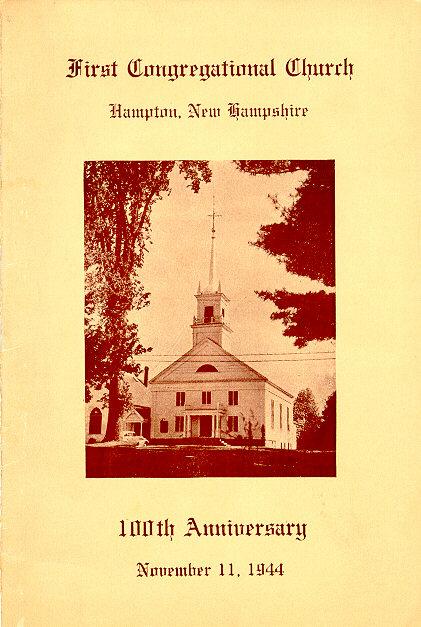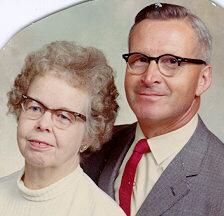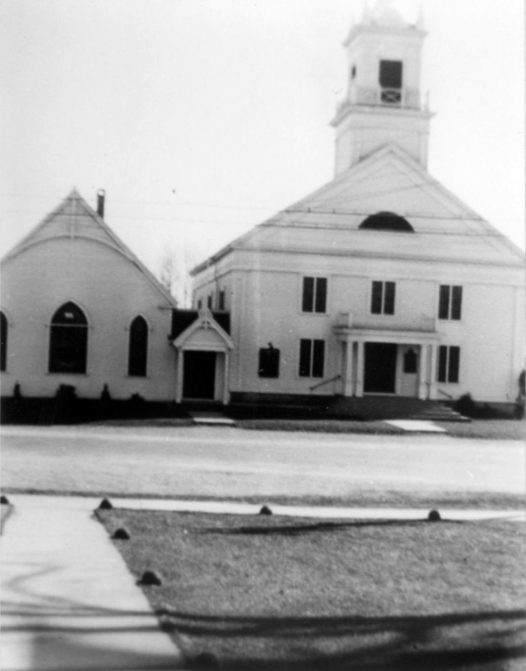First Congregational Church
Hampton, New Hampshire

100th Anniversary
November 11, 1944
Floyd G. Kinsley, Pastor
Herbert Walker, Pastor Emeritus
Organ Recital
FIRST CONGREGATIONAL CHURCH
HAMPTON, N.H.
November 11, 1944
WILLIAM E. ZEUCH
* * * * * ** * * * * *
15 Minute Program
Service Of Worship
SUNDAY MORNING AT 10:30
PRELUDE
PROCESSIONAL HYMN, "When Morning Gilds The Skies", No. 41
CALL TO WORSHIP, Psalm 100
Minister: Make a joyful noise unto the Lord all ye lands,
People: Serve the Lord with gladness; come before his presence with singing,
Minister: Know ye that the Lord he is God; it is he that hath made us, and not we ourselves; We are his people, and the sheep of his pasture.
People: Enter into his gates with thanksgiving, and into his courts with praise; be thankful unto him, and bless his name,
Minister: For the Lord is good, his mercy is everlasting; and his truth endureth to all generations.PRAYER (Minister and People uniting) Almighty God, Father of all mercies, we, thine unworthy servants, do give thee most humble and hearty thanks for all they goodness and lovingkindness to us, and to all men. We bless thee for our creation, preservation, and all the blessings of this life; but above all, for thine inestimable love in the redemption of the world by our Lord Jesus Christ; for the means of grace, and for the hope of glory. And, we beseech thee, give us that due sense of all they mercies, that our hearts may be unfeignedly thankful; and that we show forth they praise, not only with our lips, but in our lives, by giving up ourselves to thy service, and by walking before thee in holiness and righteousness all our days; through Jesus Christ our Lord to whom, with thee and the Holy Spirit, be all honor and glory, world without end.
Amen.THE LORD'S PRAYER
Minister: O Lord, open Thou our lips.
People: And our mouths shall show forth Thy praise.
Minister: Praise ye the Lord.
People: The Lord's Name be praised.THE GLORIA PATRI
RESPONSIVE SERVICE No. 626 ANTHEM, "Lest We Forget" DeKovanChoir
THE SCRIPTURE
SOLO, "Bless This House" Mr. Frank B. Robinson THE PASTORAL PRAYER (At the sound of the chord of the organ, the congregation will unite in our prayer for those in service.) Hymn No. 237 HYMN, "Faith Of Our Fathers" No. 220 OFFERING (Congregation rising and uniting in the offertory sentence.) No. 541 THE SERMON, "What Is The Church?" The Rev. Robert G. Armstrong, D.D. THE RECESSIONAL HYMN
"O Light, From Age To Age The Same" No. 445THE BENEDICTION
* * * * * *
COMMITTEE
* * * * * *
Rev. Floyd G. Kinsley
Samuel A. Towle
Dean B. Merrill
Mrs. Emma J. Young
Rev. Herbert Walker
Within These Walls
By Rev. Floyd G. Kinsley, Pastor
First Congregational Church
[100th Anniversary]
Hampton, New Hampshire
November 11, 1944
[An historical address delivered by the Reverend Floyd G. Kinsley (1938-1952) at the observance of the one hundred years use of the First Congregational Church Building in Hampton, N.H.]

Polly & Floyd G. Kinsley
[Photo courtesy Virginia Bailey]
It is interesting to note that, of the six buildings used for the services of worship of this Church, now 306 years old, the building in which you are now seated has been used for church services longer by far than any one of the others. We feel a warmth, richness, dignity, and beauty in the blending of the old and new, which the faithful souls who attended the dedication of this building one hundred years ago could not possibly have felt.
No longer is the bass viol, purchased two years after the dedication of this building used to lead the people in singing, nor the pipe organ in the rear gallery, which some present have pumped. The old fashioned pews, with doors which were first removed because they made too much noise, are replaced by pews which you must admit are quite comfortable compared to some in which people slumber of a Sabbath morning. Gone also are the two stoves in the rear, with their unsightly pipes which ran the whole length of the room, dropping creosote along their straight course to the front. Hardwood floors have replaced the old soft wood floors, and countless other changes have taken place. The Webster Memorial Chapel, interestingly enough just half as old as this building, has been added. During Mr. Walker's pastorate this lovely chancel was added with the rooms on either side, and the kitchen below. The dining room was enlarged, and a modern heating plant was installed. Two serious fires have not left a trace to mar the beauty of this ancient House of God. Is not the increased usefulness and beauty of the building as the new and the old have been blended a fitting symbol of the increased power and usefulness of our religion as we let new ideas and trends, crystallize, purify, and strengthen the old?
This skillful blending of the old and new links us in a very real way with the meeting houses of the past and the rich spiritual heritage of this Church. Most outstanding of these connections is the grand old pulpit from which I am now speaking. This first appeared in the fifth meeting house, now the town hall across the way, and dedicated in 1797. This meeting house, built as the result of a schism in the Church, was the first to be built off what is known as "Meeting House Green." It had square pews and galleries, and was built with money secured from selling the pews to the highest bidder. People by this time must have begun to think more of bodily comfort, for it was in this building the stoves were first introduced for heating. Although we would not consider square pews too comfortable, they did mark a definite advance over the backless seats of the former houses of worship. Later in 1811, a steeple was built at the cost of $900 and a bell placed therein, reminding us of the fact that in or near each of the preceding buildings had been placed a bell, used to call the inhabitants of the town to divine worship; also reminding us of the devotion of the faithful bell ringers, than which there is no greater than that of our present bell ringer, Edward P. Brown. The best pews were around the three sides of the room, two steps from the floor. They had straight board seats on three sides and were closed in by doors. Other pews filled the floor. On one of the posts near the middle of the room, notices were posted, and if your pew was near enough, you could read the notices therefrom.
In this fifth meeting house this grand old octagonal pulpit, a remarkable specimen of the joiner's art, occupied a prominent place. At a very lofty height and surmounted by a great sounding board, this pulpit was then reached by stairs. When the present town hall was no longer used as a church building, the old pulpit was placed in the wood room. Its next resting place, exposed to sun and storm, was on the marsh at Boar's Head. After the Webster Memorial Chapel connected with our present place of meeting was built, the pulpit, much battered and weathered was placed in its cellar, and then in the chapel itself. During Mr. Walker's pastorate when this present building was remodelled, this old pulpit was used to beautify the sanctuary and to link us with the past.
One of the communion cups which you see before you, reminds us of the third meeting house on "The Green", where it was first used. Though we know not the size or form of the building, we do know that patience and persistence through five years following 1675 were responsible for its completion; for it was at that time that many of those who were working in the erection of the building were called away to fight in the Indian Wars. Fortifications were placed around the building to secure it from the violence of "the heathen" (meaning the Indians). It was in this whitewashed building that the three communion flagons, one tankard, and one basin, all pewter, were replaced by the eight silver breakers or cups, made by the famous silversmith John Coney.
The other communion cup before you, purchased with three others in 1744 reminds us of the fourth meeting house where it was first used. This meeting house, occupied in 1719, was evidently handsomer and of more artistic proportions than any of the other three built on "The Green". The glass, seats, and inside work from the previous building were used in this one. Let him who uses the discomfort of church pews and the length of the service as an excuse -- never a reason -- for non-attendance of church services be advised that there was but one pew in this building -- that for the minister's family; and that the Sunday morning service was three hours long; and that this was not the only Sabbath service. Let him remember that in these first four meeting houses of Hampton, backless seats seemed adequate! We are told, however, that in this fourth meeting house, other pews were later built.
The first two meeting houses were evidently rather rude structures, the first seemingly temporary until a more adequate meeting place could be built. The meeting houses we have described and those that followed, together with the meeting houses now used by the other church groups in the community, are reminders of the fact that it is good to come "altogether to the church and altogether pray". They too are reminders of the fact that sometimes of late, we have been neglectful in assembling ourselves together, as our fathers were wont to do.
Because of its associations with the long past, and the hallowed memories of those whom we have "loved and lost awhile", who as we, worshiped God in this sacred place, we have come to love this building. Here we have brought our babes to be blessed by the church; here we have brought our loved ones for the last rites, and heard words of hope; here we have offered our prayers, heard and studied God's faithful servants; here we have raised our voices in praise and song; and the very walls are endeared to us. It is natural and right that this should be so.
But to use the words of beloved Father Ross, "the building for worship is not to be the retreat for spiritual laziness where we should sing and pray and utter holy sentiments, and then go out and forget what we have prayed for, and in deed and life contradict what we have said. It is rather to be the shrine where the knight watches and prays that he may be strengthened for wearing the consecrated armor, and fighting valiantly and successfully the battles of the holy warfare". Letting this shallowed building thus serve us, let us "press toward the mark for the prize of the high calling of God in Christ Jesus."
Man can build a spire.
With peace beneath its towering cross
Enkindling his faith's fire.
With stone and mortar, brick and wood,
Here upon the sod
He raised his temple beautiful
Wherein to speak with God.
[--"Country Church": Dan MacKenzie]

